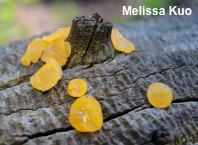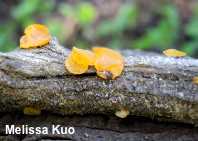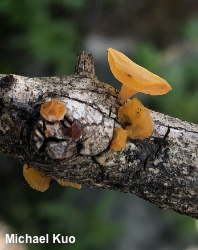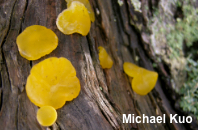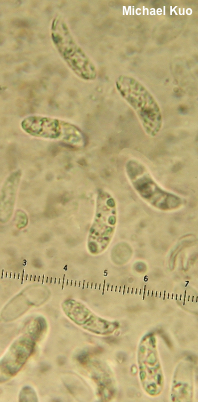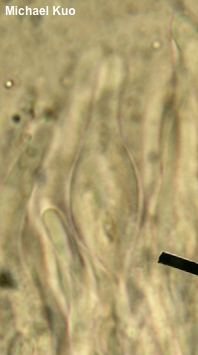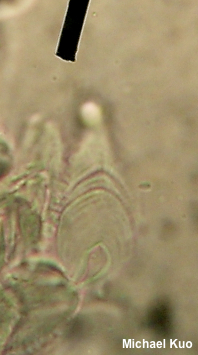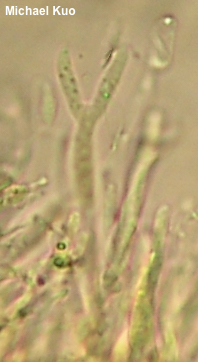| Major Groups > Jelly Fungi > Guepiniopsis alpina |

|
Guepiniopsis alpina [ Basidiomycota > Dacrymycetales > Dacrymycetaceae > Guepiniopsis ... ] by Michael Kuo This western jelly fungus can often be recognized without recourse to microscopic study. It appears on the barkless deadwood of conifers in the mountains and features a disc-like upper surface and, underneath that, a cushion-like or top-shaped body. The whole thing is yellowish orange to orangish yellow, often about 1–2 cm across. It typically appears in spring, just after snows have melted—but here I am defining "spring" by the snowmelt, and by this definition spring comes to montane ecosystems in summer or even late summer, depending on elevation. However, I have also found Guepiniopsis alpina up to six weeks after snowmelt. Microscopic features are distinctive and definitive; they include spore morphology, clamp connections, and impressive, thick-walled, lageniform cortical hairs arranged in a palisade on the mushroom's undersurface. Guepiniopsis minuta, also known as Dacrymyces minutus, is a similar but slightly smaller species that appears on the wood of eastern hemlock. Guepiniopsis buccina appears on the deadwood of hardwoods, typically develops a well-defined, elongated stem, and lacks clamp connections. Guepiniopsis chrysocoma is a much smaller species best separated microscopically; it has larger, wider spores and clavate cortical hairs that lack thickened walls. Species of Dacrymyces can look similar but are usually more lobed, blob-like, or brain-like, and lack a clearly differentiated upper surface (see illustration to the right for comparison). Heterotextus alpinus is a synonym. Description: Ecology: Saprobic on the deadwood of conifers; growing gregariously to densely gregariously from cracks in the wood; spring through late summer (but see the discussion above); distributed in western North America from the Rocky Mountains westward; also known from South America and Europe. The illustrated and described collections are from Colorado. Fruiting Body: More or less disc-shaped, or shaped like a top, with a clearly defined upper surface; 4–20 mm across; without a clearly defined stem but sometimes developing a pseudostem. Upper Surface: Bright to pale yellowish orange or orangish yellow—or simply orange or yellow; bald; flat or with a few wrinkles; the margin sometimes appearing finely scalloped. Undersurface: Colored like the upper surface, or slightly darker; rugged but bald; not grooved. Pseudostem: When present, shaped like an inverted cone; colored and textured like the undersurface. Flesh: Orangish to yellowish; gelatinous and softly rubbery. Odor: Not distinctive. Microscopic Features: Spores 11–17 x 4–5 µm; cylindric to allantoid; smooth; long appearing aseptate but eventually developing 2–3 septa; hyaline in KOH. Conidia often present; 4–6 x 2–3 µm; ellipsoid to lacrymoid or very irregular; smooth; hyaline in KOH. Basidia Y-shaped; 40–50 x 2–3 µm; smooth; yellow in KOH. Probasidia similar to basidia but smaller, or with shorter "tongs," or unbranched and fusiform to cylindric. Contextual hyphae 2–3 µm wide; smooth; hyaline or, en masse, golden in KOH; with large, looping clamp connections. Cortical hairs arranged in a palisade; 25–50 x 5–22 µm; fusiform to lageniform or ob-pyriform; with very thick, gelatinous walls that sometimes appear zonate; hyaline in KOH; smooth or a little granular. REFERENCES: (Tracy & Earle, 1901) TW Brasfield, 1938. (Martin, 1932; Brasfield, 1938; Martin, 1952; Olive, 1954; Lowy, 1971; Reid, 1974; Arora, 1986; States, 1990; Phillips, 1991/2005; Lincoff, 1992; Trudell & Ammirati, 2009; Desjardin, Wood & Stevens, 2015; Evenson, 2015; Cripps, Evenson & Kuo, 2016; Læssøe & Petersen, 2019.) Herb. Kuo 08060506, 07261905. This site contains no information about the edibility or toxicity of mushrooms. |
© MushroomExpert.Com |
|
Cite this page as: Kuo, M. (2020, February). Guepiniopsis alpina. Retrieved from the MushroomExpert.Com Web site: http://www.mushroomexpert.com/guepiniopsis_alpina.html |
